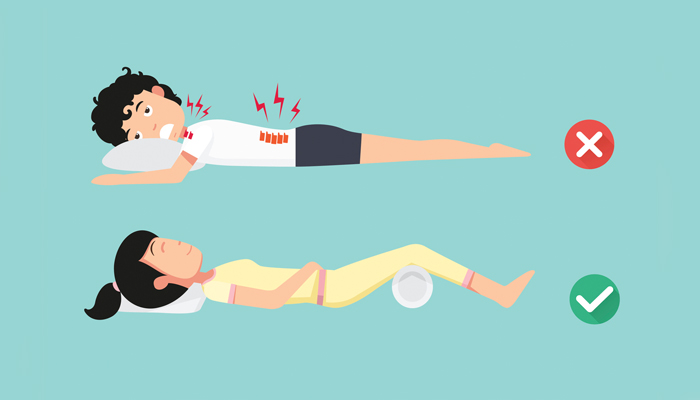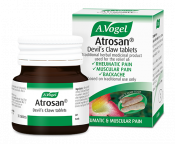Why do I get neck pain after sleeping?
Everyday neck pain can come about suddenly, such as after an accident, or it may develop over time because of problems in the individual vertebrae of the spine. However, what if you notice the pain is only there in the morning?
Well, muscles, tendons and ligaments often become stiff after periods of inactivity, more so if they've been fixed in an awkward position for long periods. This means that your sleeping position, your choice of pillow or mattress, or even being pregnant, can all contribute to neck pain after sleeping.
How to ease neck pain in the morning
What natural steps can you take to relieve pain and stiffness in the neck in the morning? Here are my top suggestions.
1. Sleep on your side or back
If you find your neck pain is most troubling in the morning, it could be down to your sleeping position. Although maintaining the correct position for your neck isn't entirely under your control, as we tend to fidget and turn during the night, you can at least start the night well and get into good habits.
So, to keep neck pain at bay, never sleep on your front, as the neck angle needed to turn the head to breathe is too extreme. Sleeping on your back or your side is far better but the most comfortable position of these will be dictated by the nature of your neck issue, your own anatomy and your personal experience.

2. Use one, firm pillow
Advice on pillows is mixed. Some say to use a feather pillow or any soft filler, whilst others promote memory foam pillows. There are also pillows shaped for those who sleep on their back and on their side. However, what these all forget (and it's your money they're being forgetful with – I've seen a pillow selling for £120!) is that we fidget and turn during the night.
Pillows that claim to offer support to the back or neck are called orthopaedic pillows, should you wish to do your own research. You may see orthopaedic pillows for the neck under 'cervical' pillows, as the neck is the 'cervical' part of the spine. These pillows tend to have a deeper indent where your head would rest and a bulge under the neck to support the spine.
What's pretty much said by all the experts, though, is just to use one, firm pillow. Overly soft pillows allow the head to sag, whilst overly hard fillings, or multiple pillows, bend it too far the other way.
So, take a look at an orthopaedic pillow but make sure you've tried adjusting the current number of 'normal' pillows you use right now before spending lots of money.

3. Look at your mattress
There isn't a lot of good quality research investigating mattress choice and back pain relief, never mind relief from neck pain, so we have to rely on common sense.
It's likely that a super soft mattress will allow the whole body to sink into the bed, meaning the spine is anything but straight when lying on your side. This would create an unnatural neck angle as the shoulders would sink too far below the head.
The same soft mattress would also allow your bottom and shoulders to sink when sleeping on your back, meaning an unhealthy and unsupported body. If you imagine turning this sleeping position to a vertical plane, you'd certainly be uncomfortable walking with that posture.
Try to remember how many years ago you bought your mattress and when you last turned it. Then, perhaps consider buying something a little more supportive or investing in a supportive mattress topper. It is recommended that we replace our mattress every eight years or so.

4. Use a natural remedy to relieve discomfort
The best natural treatments I can recommend for neck pain are heat and arnica gel.
If you wake up with a sore neck in the morning and have time, take a bath, letting the water support the weight of your head. If you don't have time for a hot bath, try a hot shower and focus on allowing the water to hit the neck. Alternatively, hot water bottles for the neck are now widely available online and in shops so you could try one of these.
Once the muscles are nice and warm, apply some Atrogel arnica gel. It's licensed for muscular aches, pain and stiffness, and can be used by pregnant and breastfeeding women, with the permission of your midwife or doctor.
If you don't have time for heat therapy in the morning, simply rub some Atrogel on when you wake up and it will quickly start to soothe your muscles.
Some articles suggest applying cold treatments to a painful neck but this could cause the muscles to become stiffer as they contract, whilst the connective tissues may become inflexible. Cold therapies are best kept for inflammatory situations, such as the swelling after injury. Read more about the differences between heat and cold therapy here.
5. Do some gentle exercise
We can only give general advice here. So, if you know you have a chronic neck complaint, such as cervical spondylosis, numbness or tingling in the arms or hands, then be sure to see a physiotherapist, chiropractor or osteopath for a detailed and individual examination and recommendations. This can be done through your doctor or privately.
However, if you're content that you've nothing more than a stiff neck, we like the idea that those weakened tissues could be rehabilitated with some good old-fashioned exercise. So, here are some exercises that that should help strengthen the deconditioned and strained muscles of the neck, and that will take just 10 minutes to perform.
Exercise 1: Standing, drop your head to the right while continuing to look ahead. Hold for 10 seconds and swap sides. Repeat twice more each side. To increase the stretch, drop the opposite shoulder.
Exercise 2: Standing again, lower your chin to your chest, hold for 10 and then look up to the ceiling and hold for 10. Repeat twice more. A more advanced version of this would be to lie on your front on the end of the bed with just your head over the end. Slowly nod it up and down to strengthen those same neck muscles further.
Exercise 3: Next, standing straight again, look over your right shoulder and hold firm for 10 seconds, then your left shoulder for 10. Repeat this 3 times. You'll notice more of a pulling or pinching sensation on one side more than the other, which shows you've targeted the muscle knot responsible.
Exercise 4: Lying on your back and staring straight up, put your tongue into the roof of your mouth and tuck your chin towards your chest for a count of 10. Then lift your head from the floor, trying to imagine the bend is at the base of the skull, between the ears. Hold this for 10 seconds and relax. Try to do this slowly for two minutes. This lengthens the muscles in the back of the neck.
Exercise 5: Finally, while sitting straight, extend your head forward and hold for 10, then all the way back and hold for 10. Repeat another 5 times and that's your 10 minutes done.

How can I relieve neck tension in pregnancy?
If you're pregnant and suffer the usual aches and pains, you must take practical steps to address it because taking pain killers isn't an ideal or long-term option.
Do remember that a lot of neck pain in the first trimester is caused by hormonal changes and so, as these settle down, so should the neck pain. However, as your baby grows bigger, the last trimester can be quite uncomfortable.
As the lower back becomes strained and the bump ever more intrusive, pregnant women can find themselves trying all manner of strange sleeping positions to ease the discomfort. Since the back and neck are so closely connected, some of the more radical positions, such as propping your upper body up with 4 or 5 pillows, might relieve the lower back but cause a whole new joy – a sore neck.
Lower back pain and sciatica are often greatly relieved when the lower spine is 'opened up'. The simplest way to do this is to pop a couple of pillows under the knees if you prefer sleeping on your back, or between the knees if sleeping on your side. If you are then able to find the perfect neck pillow, you should find that any neck pain also resolves itself.

Remember…
A stiff neck after sleeping can be painful, uncomfortable and impact the rest of your day. But, with these simple changes to your sleep environment, position and morning exercises, now you don't have to grin and bear it! However, if your pain is persistent or worsens, please consult your doctor.







 Looking for a treatment to relieve pain in conditions such as muscle aches or pains, stiffness, rheumatic pain or after sporting injuries?
Looking for a treatment to relieve pain in conditions such as muscle aches or pains, stiffness, rheumatic pain or after sporting injuries?

